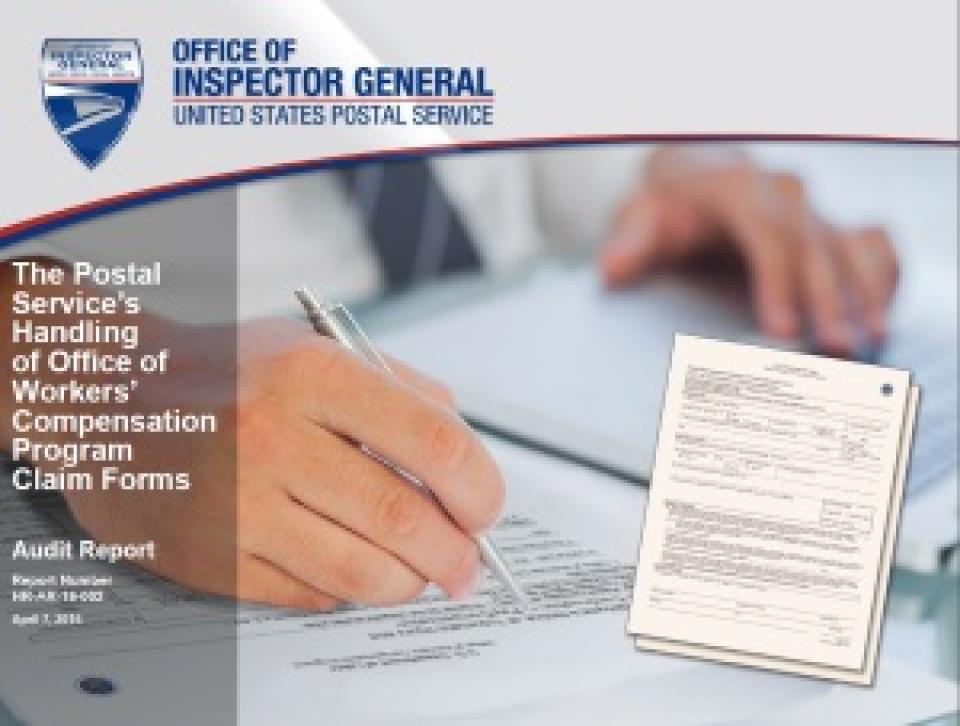The Postal Service's Handling of Office of Workers' Compensation Program Claim Forms
Background
In fiscal years (FY) 2014 and 2015, the Federal Employees’ Compensation Act (FECA) provided over $1 billion in annual workers’ compensation benefits to U.S. Postal Service workers for personal injury, disease, or death sustained while working. The U.S. Department of Labor’s (DOL) Office of Workers’ Compensation Program (OWCP) administers the FECA for the Postal Service.
Postal Service district offices must manage the Injury Compensation program by reporting accidents, incidents, and illnesses in the Employee Health and Safety (EHS) system within 24 hours of being notified by employees.
The DOL OWCP also requires Postal Service employees to file various processing forms for work-related injuries and illnesses and provide them to their supervisors, such as the CA-1 Notice of Traumatic Injury and Claim for Continuation of Pay Compensation, CA-2 Notice of Occupational Diseases and Claim for Compensation, and CA-7 Claim for Compensation.
An employee’s supervisor must submit these forms to district officials, who review them for completeness and submit them to the DOL OWCP within 10 business days of notification. The DOL bases timeliness on the number of days between the notification date and the date the DOL receives the form. The DOL publishes a quarterly report on its website of how long agencies took to submit forms.
This audit report responds to a complaint regarding the Postal Service’s handling of OWCP claim forms in the Capital District. We expanded our scope to the Hawkeye District because of a related congressional inquiry and to the Arizona and Suncoast districts due to the high volume of OWCP claim forms those districts processed timely. In FY 2014 through Quarter 3, FY 2015, these districts collectively recorded over 6,000 OWCP-related incidents and accidents.
Our objective was to determine whether the Postal Service appropriately handled OWCP claim forms to ensure they were submitted to the DOL accurately and timely.
What the OIG Found
The Postal Service did not appropriately handle claim forms to ensure accurate and timely submission to the DOL. Specifically:
In 102 of 471 (22 percent) case files reviewed, personnel made improper revisions to the employee and supervisor sections of the claim forms. Specifically, in 77 of 102 case files, personnel in the Arizona, Capital, Suncoast, and Hawkeye districts improperly revised dates on forms in three places: 1) the date the employee completed the form, 2) the date the supervisor was notified, and 3) the date the supervisor signed the form. In 25 of 102 case files, personnel in Arizona and Suncoast districts improperly revised, but revisions were not limited to, the place and the date injury occurred, the cause and the nature of injury, the date stopped work, the date pay stopped, and the date returned to work. Revising information on the claim forms without documenting the changes gave the appearance that claim forms were completed and submitted timely to the DOL. We referred these incidents to our Office of Investigations for further review.
In addition, personnel in Arizona, Suncoast and Hawkeye districts did not date stamp 50 of 438 incoming claim documents (11 percent) as required. Also, personnel in Arizona and Suncoast districts did not date stamp 30 of 364 outgoing claim documents (8 percent). Although not a requirement, the Postal Service should date stamp outgoing OWCP documents as a best practice to ensure timely claims submission to DOL. Because forms were not date stamped, there was no reasonable assurance that forms were processed timely.
Finally, Postal Service supervisors in the Arizona and Suncoast districts did not report 118 of 364 (32 percent) incidents in the EHS system within 24 hours as required. Untimely reporting of incidents in the EHS system does not provide Postal Service management with real-time accidents or illnesses data for reporting purposes.
These conditions occurred because the Postal Service used a labor-intensive manual claims process for OWCP claim documents, which increased opportunities and the risk for personnel to alter the documents. Additionally, personnel in the Capital and Hawkeye districts stated they felt pressure because although no longer a goal, the Postal Service monitors timeliness for OWCP claim form submission.
In addition, district personnel were not always aware of policies and procedures for claim forms; and the Postal Service did not establish policies and procedures for revising pertinent dates on the CA-1 form, or revising CA-2 and CA-7 forms, and date stamping outgoing claim documents. Lastly, supervisors did not submit incidents into the EHS system within 24 hours as required because they stated the system was slow and not user friendly.
A more comprehensive electronic claims process could reduce the risk of improper document revisions and improve the timeliness of claim form submissions to the DOL. Insufficient controls over the claims handling process and improper alteration of pertinent dates on claims forms could harm the Postal Service’s brand and integrity.
What the OIG Recommended
We recommended management develop a more comprehensive electronic claims process. We also recommended mandatory training on policies and procedures for claim forms, establishing policies and procedures for revising dates and date stamping outgoing claim forms, and evaluating the EHS system to enhance usability and efficiency.

